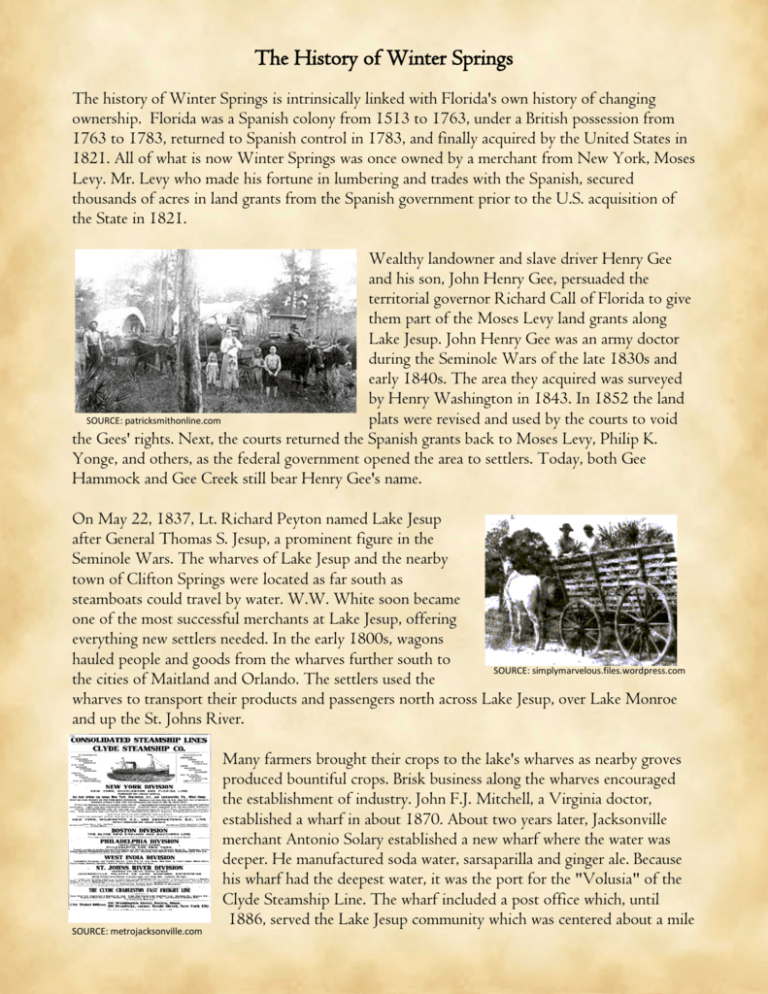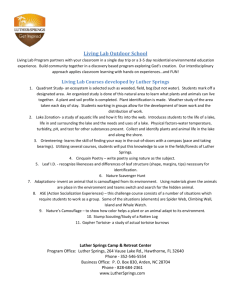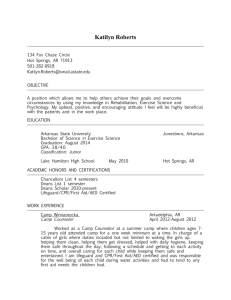The History of Winter Springs
advertisement

The History of Winter Springs The history of Winter Springs is intrinsically linked with Florida's own history of changing ownership. Florida was a Spanish colony from 1513 to 1763, under a British possession from 1763 to 1783, returned to Spanish control in 1783, and finally acquired by the United States in 1821. All of what is now Winter Springs was once owned by a merchant from New York, Moses Levy. Mr. Levy who made his fortune in lumbering and trades with the Spanish, secured thousands of acres in land grants from the Spanish government prior to the U.S. acquisition of the State in 1821. Wealthy landowner and slave driver Henry Gee and his son, John Henry Gee, persuaded the territorial governor Richard Call of Florida to give them part of the Moses Levy land grants along Lake Jesup. John Henry Gee was an army doctor during the Seminole Wars of the late 1830s and early 1840s. The area they acquired was surveyed by Henry Washington in 1843. In 1852 the land SOURCE: patricksmithonline.com plats were revised and used by the courts to void the Gees' rights. Next, the courts returned the Spanish grants back to Moses Levy, Philip K. Yonge, and others, as the federal government opened the area to settlers. Today, both Gee Hammock and Gee Creek still bear Henry Gee's name. On May 22, 1837, Lt. Richard Peyton named Lake Jesup after General Thomas S. Jesup, a prominent figure in the Seminole Wars. The wharves of Lake Jesup and the nearby town of Clifton Springs were located as far south as steamboats could travel by water. W.W. White soon became one of the most successful merchants at Lake Jesup, offering everything new settlers needed. In the early 1800s, wagons hauled people and goods from the wharves further south to SOURCE: simplymarvelous.files.wordpress.com the cities of Maitland and Orlando. The settlers used the wharves to transport their products and passengers north across Lake Jesup, over Lake Monroe and up the St. Johns River. SOURCE: metrojacksonville.com Many farmers brought their crops to the lake's wharves as nearby groves produced bountiful crops. Brisk business along the wharves encouraged the establishment of industry. John F.J. Mitchell, a Virginia doctor, established a wharf in about 1870. About two years later, Jacksonville merchant Antonio Solary established a new wharf where the water was deeper. He manufactured soda water, sarsaparilla and ginger ale. Because his wharf had the deepest water, it was the port for the "Volusia" of the Clyde Steamship Line. The wharf included a post office which, until 1886, served the Lake Jesup community which was centered about a mile to the south. Mills Lord brought the mail here twice a week by rowboat from across the lake. The growth of Oviedo and the establishment of a post office there in 1879 led to the decreased importance of the wharf. In April of 1882, the Lake Jesup Steamboat Company was formed by stockholders Antonio Solary, Henry Foster, Andrew Aulin and George Browne. They planned to use it to transport their fruit to market over Lake Jesup, which in the 1880s could not be entered by a boat drawing more than three feet. The problem was Lake Jesup is only about six feet deep in most places. Enter Capt. Eugene Bigelow who had the SOURCE: metroJacksonville.com steamship "Isis" running between Jacksonville and Lake Jesup by December of 1881. The appearance of the 100-foot, flatbottomed, iron-hulled steamship encouraged the local residents to incorporate and buy an interest in the "Isis". They modified it, and began shipping oranges north up the Saint Johns River. The venture came to an abrupt end on November 6, 1882, when she sank in a heavy storm on Lake George. George H. Browne came to the area in about 1871, and worked in Solary's store, first as Solary's clerk and then as his partner. He also served as the last postmaster for the Lake Jesup community, from 1881 to 1886. Browne lived in Oviedo until 1911. Lumber and logging ventures, sawmills, and turpentine stills were built in the area. Soon cattle became one of the frontier industries, and even more orange groves were planted bringing extended railroads to serve them. SOURCE: galleryhip.com Vincent Lee was an early homesteader here, and partners George C. Brantley and Col. Daniel Randolph Mitchell located their wharf and store by an area today known as Tuskawilla landing. The Brantley store was in existence as early as 1865, and in 1874 Brantley bought a nearby site. He named it Tuskawilla after an Indian village of the same name in Alachua County now known today as Micanopy. In the early days of the settlement, Tuskawilla Road was a rugged wagon trail blazed for the construction of railroad tracks from Lake Jesup to Orlando. In 1873 the efforts of George Brantley and Daniel Mitchell failed suddenly when both died while the railroad bed grading was only half completed. The city we know as Winter Springs today was originally incorporated as North Orlando in 1959, when it boasted no more than 600 residents. The name lends itself from the North Orlando Company and its efforts to grow the community from a small village. SOURCE: City of Winter Springs The oldest public building of Winter Springs opened in 1960 as the office of the North Orlando Company. This building also served as the village hall, then served briefly as the city hall. In 1962, the 3400 acres belonging to the Winter Springs Development Company were annexed and the village was re-chartered as the City of Winter Springs. The growth of the Central Florida region as a whole contributed to the City's steady development. In 1968 nearby Florida Technological University opened, and has grown to become the nation's third largest university, the University of Central Florida (UCF). The continued development of UCF, its adjacent Research Park, and the growth and development of Central Florida's aerospace and defense industries has fueled consistent, steady development of high quality, suburban style residential neighborhoods. Since the 1970s the focus on up-scale neighborhoods SOURCE: City of Winter Springs and a better quality of life has made Winter Springs one of Central Florida's premiere destinations. In 1972, the City incorporated its name to Winter Springs, and is now the largest city in Seminole County, on the basis of land area. The Winter Springs Town Center, designed to replicate the feel of “old town” Florida in the geographic heart of the city, opened in 2002. This mixed-use development provides an urban center for the City with a 54,000 SF Publix store and 61,000 SF of specialty retail shops and office space. Winter Springs is now home to over 33,282 people and is poised to remain one of the state's most livable ‘small towns'. Money magazine recently listed Winter Springs on America's Top 100 Best Places to live list. Sources for Winter Springs History: Bibliography, a History of the First United Methodist Church of Winter Park, by W. Breathitt Gray, Jr. (Ferris Printing Co. 1992) A Sightseeing Tour of Seminole County Historic Sites, (Seminole County Historical Commission 1991) Early Days of Seminole County, Florida, by Arthur E. Franke, Jr. (Seminole County Historical Commission 1988) Flashbacks: The Story of Central Florida's Past, by Jim Robison and Mark Andrews (The Orlando Sentinel 1995) Historical and Architectural Survey, City of St. Cloud, Project Report, by Brenda J. Elliott and Associates (1993) The Winter Springs Historical Trail, by Steve Rajtar, 1999. The Orange County Historical Society, and the Orlando Sentinel Winter Springs.com (Telemarket Resource Group, Inc.)







